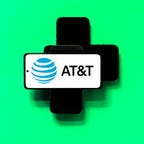Best AT&T Plans: How to Choose and Which Ones to Pick in June 2024
AT&T has four main unlimited plans listed on its website. We try to make sense of them.
Our Picks


When it comes to wireless plans, AT&T is among the simplest. Like its rival US carriers, AT&T offers a variety of different options, all with the promise of "unlimited" talk, text and data. Unlike T-Mobile, which has a variety of options listed on its website, AT&T has a much simpler offering (albeit with worse names):
- Unlimited Starter SL
- Unlimited Extra EL
- Unlimited Premium PL
- Value Plus VL
All offer unlimited talk, text and data, but all also have different prices, features and perks. Which ones should you consider? Let's break it down.
Read more: Our Guide to the Best Cell Phone Plans
AT&T has two largely similar base plans, the Unlimited Starter SL and Value Plus VL. Both include unlimited talk, text and data and lack an allotment of high-speed data so in either scenario you could find yourself slowed down in busy areas (think packed stadiums or arenas). You can tap into AT&T's 5G network, and both plans also include unlimited talk, text and data in Canada and Mexico.
The biggest differences are that Starter SL includes 5GB of hotspot data per line and Value Plus VL needs everyone on your account to be on the same plan. Most people don't need the hotspot data and, in that case, will probably be fine with Value Plus VL and are better off saving the money.
Rounding up, one line of Value Plus VL is $51 while a single line of Starter SL is $66 (both factoring in automatic payments and paper-free billing). Spending an extra $15 a month for 5GB of hotspot data seems excessive. The difference at four lines is $20 a month ($124 for Value Plus VL versus $144 for Starter SL). At least in this case, getting Starter SL will allow you to put other people on your plan who need more features, like international roaming in Latin America or more high-speed or hotspot data, to be on pricier AT&T plans like Extra EL or Premium PL while those who don't need such options stay on the cheaper Starter SL.
It is also worth noting that Value Plus VL may not qualify for AT&T's upgrade deals, so those looking for new devices may need to look at Starter SL instead.
AT&T doesn't push the Value Plus VL and hides it behind a "more plans" section on its plans page.
The upgrade pick for those who want faster data or hotspot
AT&T Unlimited Extra EL
Unlike T-Mobile and Verizon, AT&T no longer offers perks like bundled streaming services. While it used to offer HBO (now Max) with its older top plans, today its pricier options largely differentiate themselves with how much hotspot or high-speed data it offers domestically and in 20 Latin American countries.
For people looking for a step up from AT&T's base plans, and aren't regular travelers to Latin America, our pick is the company's Unlimited Extra EL. With this plan, you get 75GB of high-speed data and 30GB of hotspot capability.
A single line of Extra runs $76 a month (assuming automatic payments and paperless billing), while if you had four lines it would be around $164 monthly ($41 per line). Like Starter SL and Premium PL, AT&T allows those with this plan to "mix and match" lines on a family account so if only one person needs extra data or hotspot they can be on this plan while others are on the cheaper Starter SL.
AT&T's top plan, Premium PL, is $10 more per line, per month than Extra EL. For that price you do get unlimited high-speed data with no limits, 60GB of hotspot data per month, the ability to stream content on your phone in 4K and unlimited talk, text and high-speed data in 20 Latin American countries. For most people, we think you'd be better off saving the money and getting the step-down plan (and potentially upgrading to this option for a month if you're traveling or need more data).
Factors to consider: Know your area
As we covered in our other wireless guides, to get the best deal you need to make sure you have the coverage that you need. This makes it hard to give a blanket recommendation of any one carrier. T-Mobile's service in New York may be excellent, but if you're in rural Iowa, Verizon is more reliable.
While your mileage may vary, the good news is that these networks are growing and improving all the time, particularly as the three major players race to blanket the US with 5G. It's quite possible that you left a network complaining about its sparse service a decade ago, but now it's beefed itself up because of that race to acquire customers.
If you know any friends or family in your area that already use the carrier you're considering, ask about their experience. You could also go to a carrier's store and see if they offer any free ways to try out the service before switching over, such as T-Mobile's Network Pass. Verizon offers a similar 30-day "Test Drive" program, while the Cricket prepaid service has its own trial program that lets you sample parent AT&T's network.
How we test
Picking a wireless plan and carrier is an individualized process. What works for you and your family's needs may be vastly different from your friends or neighbors. Even geographically, some areas have better AT&T coverage while others work best on Verizon or T-Mobile (and vice versa). Our picks are based on over a decade of covering and evaluating wireless carriers, their offerings and their performance.
Since choosing a provider is unique, we focus on larger plans and the value they provide; as well as calling out ways you can test the different networks in your area for yourself so you can make the best pick.

